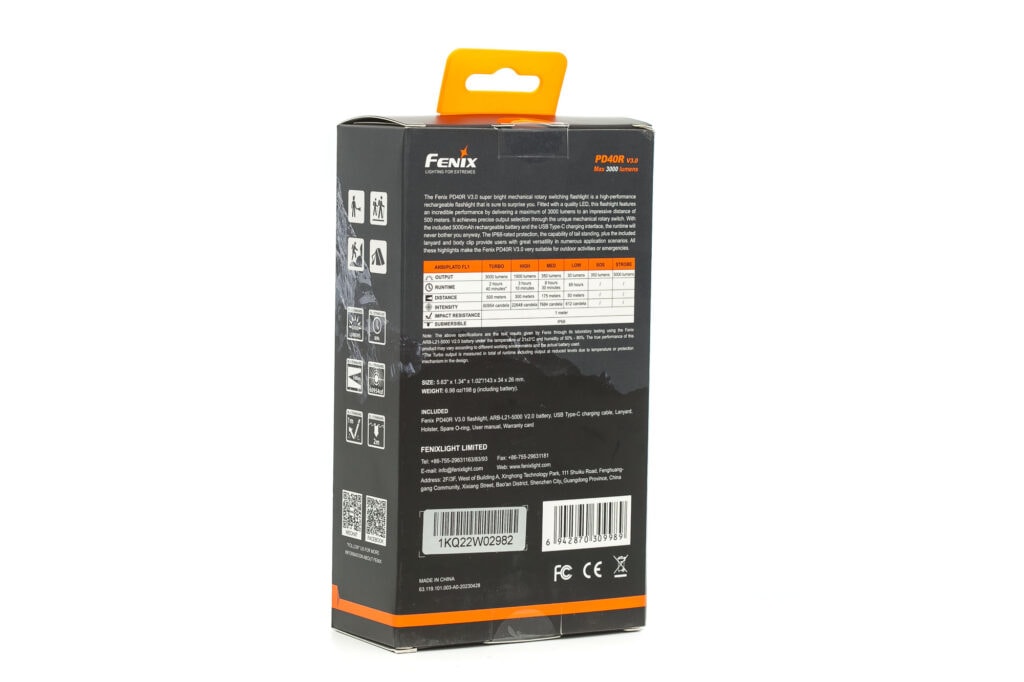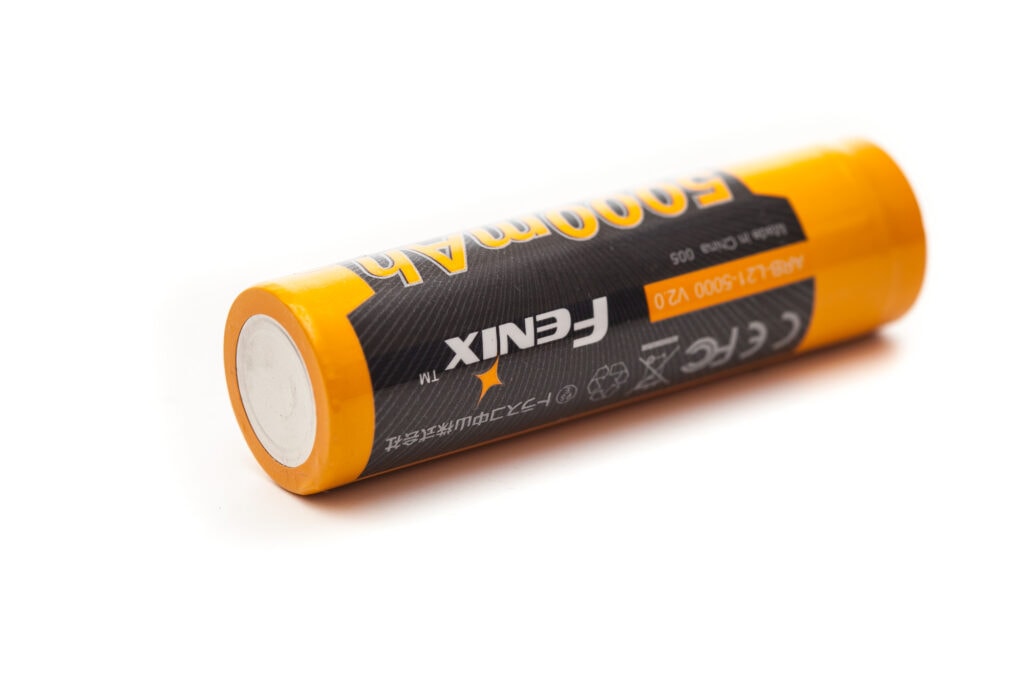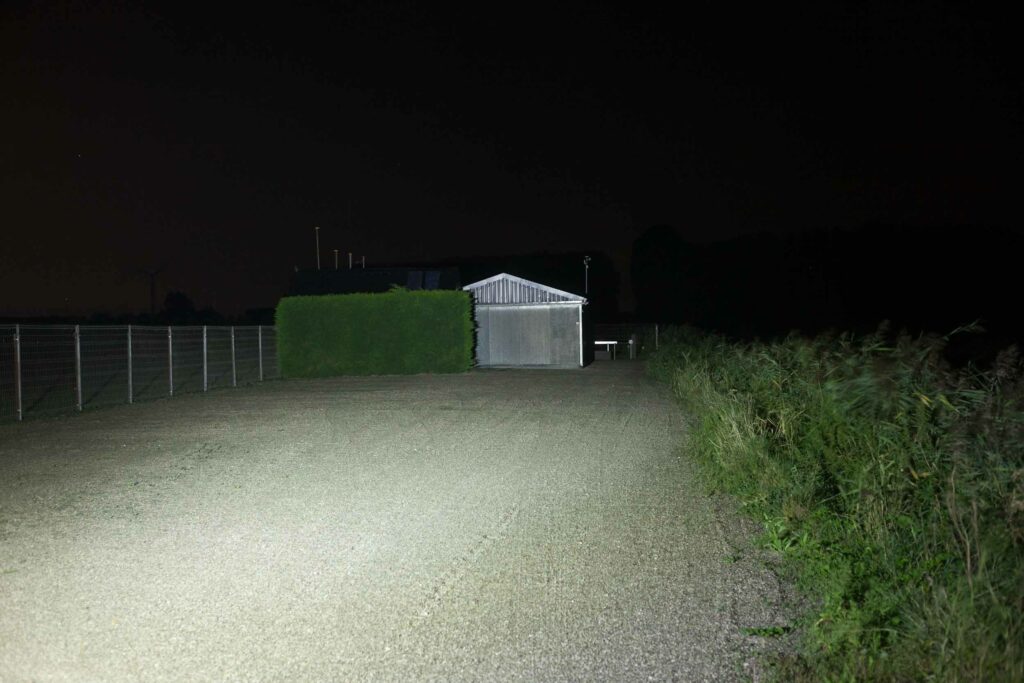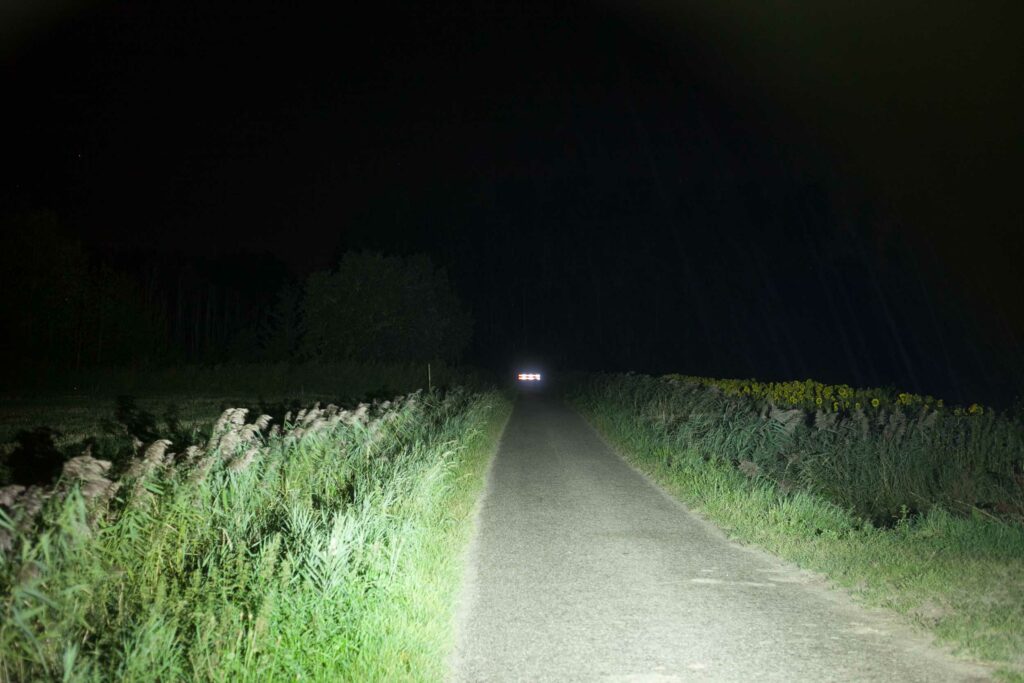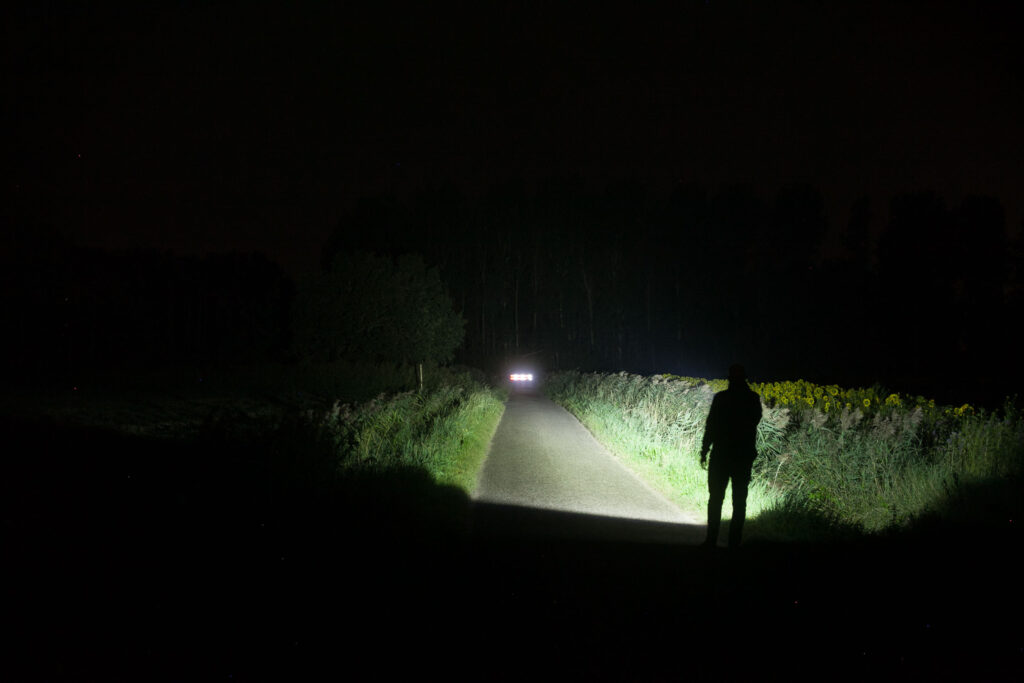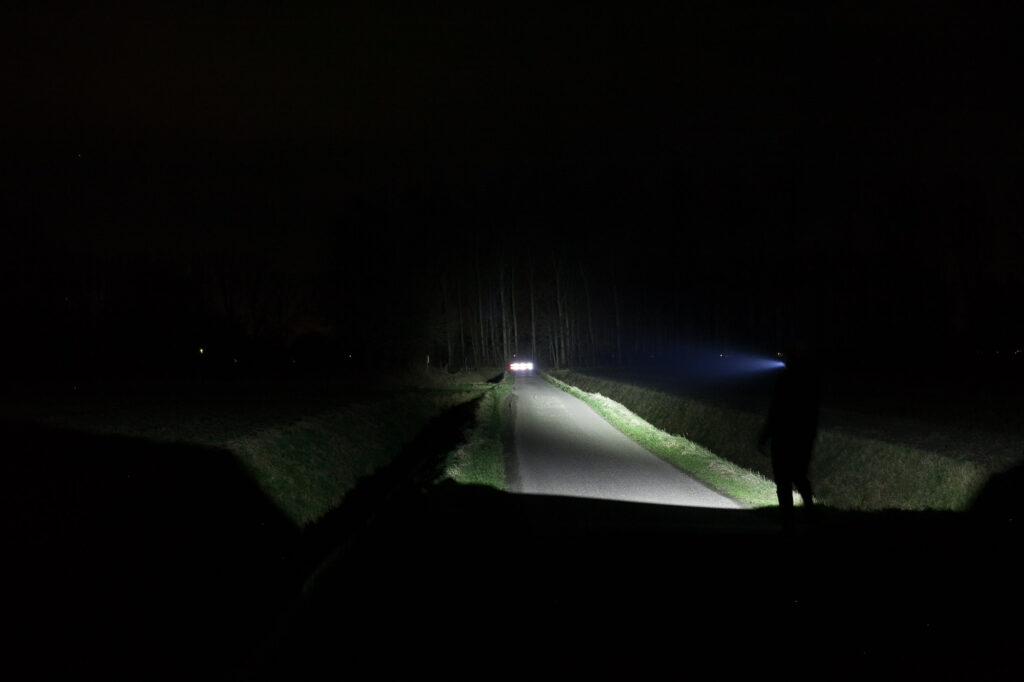1lumen selects and reviews products personally. We may earn affiliate commissions through our links, which help support our testing.
Fenix PD40R v3 review
Fenix PD40R v3 specifications
| Brand/model | Fenix PD40R v3 |
|---|---|
| Flashlight category | Duty / tactical / general purpose |
| LED | N/A |
| Max. output | 3,000 lumens |
| Max. beam distance | 500 meters |
| Max. beam intensity | 60,954cd |
| Battery config. | 1*21700 |
| Onboard charging | USB-C |
| Modes | 4 |
| Blinkies | Strobe, SOS |
| Waterproof | IP68 |
| Review date | April 2024 |
Review intro:
If you’re familiar with flashlights, you’ve encountered Fenix lights many, many times. They produce flashlights known for their simplicity, high performance, reliability, and professional-grade features.
Having reviewed and owned quite a few Fenix lights, I can attest to their quality and durability. Recently, Fenix sent over their PD40R V3, the flagship model in their PD series designed for professional users and the successor of the PD40R v2, which Nick reviewed. Compared to its predecessor, the PD40R V3 boasts the same output but an increased beam distance and a few more little updates.
What’s in the package
Fenix packaging is pretty standard, with a picture of the light on the front, including some specifications, while more detailed specifications are printed on the back. Inside the carton box, is a plastic case, that is not like your ordinary plastic inside. It’s much stiffer and harder. Here’s what you get :
- Fenix PD40R v3 (with pocket clip attached)
- Fenix ARB-L21-5000 v2 battery (21700 type lithium-ion)
- Lanyard
- Spare o-ring
- USB C cable
- Holster
- Warranty card
- Manual
Note: remove the plastic insulator under the tailcap before your first use! If you don’t the flashlight will not turn on, and the built-in charger won’t work.
Flashlight in use, Build Quality, and Warranty
The PD40R v3 is just like the v2: a general-purpose flashlight that is adaptable to a variety of use cases, whether walking your dog, camping, inspecting, etc.
It uses a control ring with seven steps, starting from standby, Low, Medium, High, Turbo, SOS, and Strobe. But you don’t need to activate them if you don’t turn the dial that far. I am also happy to say that I had no real difficulty turning the control ring with one hand (between my thumb and index finger). Nick seems to have difficulties controlling this ring one-handed, but the PD40R v3 has no real issues.
The control ring has been redesigned, so that could definitely be the solution to Nick’s problem. At least the outside looks different, with fewer flats, and they added more grip to the ring. So, it looks like Fenix read Nick’s suggestions and improved this new model upon them!
The only thing I don’t like so much is that the mode after Turbo is a blinky mode: SOS. I don’t know whether SOS or Strobe is helpful on these types of flashlights, but perhaps there is an alternative way, so after Turbo, you won’t activate SOS directly. However, there is a bit more resistance between Turbo and SOS than there is between all normal modes. And you might get used to that and feel when you enter Turbo mode.
This magnetic control ring is best used in an underhand position, because in an overhand grip, you can’t really manage the control ring that well.
Fenix provides you with 3 options for carrying besides the standard pocket-carry. These options include a pre-attached pocket clip, a lanyard, and a fabric holster. This provides sufficient options to cater to most users’ needs.
The included lanyard is adjustable in size, and the fabric holster offers two ways to carry: velcro tape for belt-carrying and a plastic ring.
The PD40R v3 lacks a switch on the rear end, but has two flat walls for lanyard attachment and can tailstand easily.
When it comes to build quality, Fenix doesn’t disappoint, but I’m not really a fan of their type of anodizing. I prefer a matte finish instead of the ‘relatively shiny’ coating they use.
Besides all the includes accessories, Fenix also provides optional accessories, like a Fenix AOD-M diffuser (traffic wand) and hard plastic holster amongst others.
Another interesting option that Fenix Lighting US gives, is 4 optional engravings. Body engraving with American Flag, Digital Camo, Topo Map, Skulls, or even your personal design! That’s pretty amazing!
Warranty:
Open Air Brands LLC, dba Fenix Lighting US, guarantees all Fenix products purchased from retailers to be made of first-class materials and therefore provides a lifetime warranty against any defects in material and workmanship. Excluded from warranty coverage is any damage to the exterior deemed reasonable wear and tear such as scratches and/or fading of color. In addition, the warranty does not apply to damage caused by abnormal or unreasonable use of any of the components.
This includes use of unapproved batteries in Fenix products (see user manuals). This warranty is in place of all other warranties, including warranty of fitness for a particular purpose and warranty of merchantability and excludes any liability for incidental or consequential damages. If your Fenix product has a manufacturer’s defect covered by our warranty, we will either repair or replace it, at our option, without charge. Most damaged Fenix products not covered by the warranty can still be repaired. If repair costs and handling charges apply, you will be notified prior to any service.
LED, Lens, Bezel, Beam, and Reflector
Fenix does not mention the LED they use, but a trained eye will notice a Luminus SFT70. This is an LED without a dome, so it is built to ‘throw,’ which is probably the reason why the new PD40R v3 claims an increase in beam distance from 405 meters to 500 meters.
The specified output of the PD40R v3 is the same as the PD40 v2, at 3,000 lumens. So, in that regard, not much has changed.
The beam itself is pretty throwy, with plenty of spill. This is largely due to the LED and its smooth reflector. Both are protected by a glass lens with purple AR-coating. In person it looks pretty cold white, and my measurements confirms that. The beam starts at around 6400K in Low mode, but goes up to 7800K in Turbo mode. That is also a bit on the high, very cold side of the spectrum.
Spectral measurements:
I used a Sekonic C800 spectrometer to measure 3 different modes at 5 meters distance.
| Mode: | CCT: | CRI Ra: | duv | TM30 Rf | TM30 Rg |
|---|---|---|---|---|---|
| Turbo | 7803 K | 70.3 | -0.0027 | 68 | 95 |
| High | 6877K | 68.8 | 0.0032 | 69 | 94 |
| Low | 6446K | 70.4 | 0.0082 | 72 | 91 |
You see that the tint (duv, either greenish or pinkish) shifts drastically between Low and Turbo..
Dimensions and its competition
Dimensions:
| Fenix PD40R v3 | Millimeters | Inches |
|---|---|---|
| Length | 143 mm | 5.6 in |
| Head diameter | 34 mm | 1.3 in |
| Control ring diameter | 35.6mm | 1.4 in |
| tailcap diameter | 26 mm | 1.0 in |
Dimensions are rounded to the nearest millimeter and the nearest tenth of an Inch.
Weight:
| Fenix PD40R v3 | Weight in grams | Weight in oz. |
|---|---|---|
| Without battery: | 126 g | 4.43oz |
| With battery | 198 g | 7.0 oz |
Weight is rounded to the nearest gram and tenth of an Oz.
Fenix PD40R v3 Flashlight comparison
Size compared to some tactical flashlights, even though the PD40R v3 isn’t particularly tactical.
Group 1, from left to right: Armytek Predator Pro, Nitecore MH25 v2 (updated), Fenix TK22 TAC, Weltool T12, Fenix PD40R v3, Olight Warrior 3S
Fenix PD40R v3 UI : User interface and driver
The PD40R v3 uses a similar control as the previous version, but it’s upgraded. It has added more grip, and it’s smoother. It doesn’t really get easier than a control ring.
Right above the control ring, there are a couple of symbols, with a Power symbol in the off position, From the first position (off), turning the ring to the right turns on in Low mode and each position advances through the modes (off, Low, Medium, High, Turbo). After Turbo, you get SOS, and Strobe. Turning counterclockwise goes backward through the modes: Strobe, SOS, Turbo, High, Medium, Low, then off.
The available main modes:
- Low, Medium, High, Turbo
The available special modes (blinkies):
- Strobe
- SOS
How the UI works when the flashlight is still turned OFF:
- Turn the control ring to the right (clockwise): Turns on in Low mode
How the UI works when the flashlight is turned ON:
- Turn the control ring clockwise to advance from Low through Medium, High, Turbo, SOS, and Strobe
- Turn the control ring counterclockwise: Reverses through the modes: Strobe, SOS, Turbo, High, Medium, Low, off
Shortcuts within the UI:
- To Low: 1 click
- You can easily select the desired output by just quickly turning the control ring.. which is basically like a shortcut. But it becomes more difficult if it’s very dark, and w
Mode memory:
- None..
Blinky modes:
- SOS, (right after Turbo,) and Strobe, at the end. I like this better than with the PD40 v2, which only had Strobe mode, directly after Turbo
Low battery warning:
- The LED indicator shows the battery state after activation for several seconds:
- Solid green LED: 100% to 85%,
- Blinking green LED: 85% – 50%,
- Solid red LED: 50% – 25%,
- Blinking red LED: 25% – 1%
Lock-out mode:
- None, just turn the dial all the way to the left. For pocket carry, I would recommend unscrewing the body from the head for a mechanical lockout.
PWM:
- None visible
Firmware / UI Conclusion:
- One of my favorite lights from the past is the Sunwayman V10R and V11R, and both had control rings. They were, however, variable control rings, unlike the ring on the PD40R, which has 4 set modes.
- But a control ring is one of the easiest and most straightforward UIs you can possibly get.
Fenix PD40R v3 Charging and batteries
Power for the PD40R V3 comes by way of a single 21700 lithium ion cell, and Fenix includes their 5000 mAh protected button top Fenix ARB-L21-5000 v2 21700 cell with the light. The battery arrived at 3.61Volts. Like the TK and other PD series flashlights, Fenix allows you to use your own batteries, so long as they are button tops.
The driver has a physical reverse polarity protection, so that necessitates the use of button top batteries. Button top, long and short will work, but flat tops don’t work.
There’s USB type C onboard charging present as well. Charge current is advertised at 2 amps, and in my tests, the highest I measured was 5.18V and 2.3A, which is about 12 Watts. In the 3 tests I’ve done, each charge time was between 2 h and 26 minutes, and 2 h and 28 minutes.
The end voltage after charging was 4.19V. And the voltage after the runtime tests were right around 2.5V, because the battery’s protection tripped after each test.
| Charge type | Fits | No fit | Avg Charge time |
|---|---|---|---|
| Flashlight with onboard USB-C | All 21700 sizes | flat tops | 2h 27min. |
Performance test
This is the gear I use for testing:
| Gear | Purpose | Link to buy |
|---|---|---|
| Hagner E4-X | Measuring beam intensity (throw) | Inquire at Hagner.se |
| 2* Extech SDL400 | Lumens and logging runtimes | Amazon.com, Amazon.co.uk, |
| Leica Disto D2 | Distance for throw measurements | Amazon.com, Amazon.co.uk, |
| Sekonic C-800 | Spectrometer for LED measurements | Amazon.com, Amazon.co.uk |
| Uni-T UTi260B | Thermal Image camera | Amazon.com, |
Lumen measurements:
How Lumens are Measured: Understanding ANSI FL1 Standards How Lumens are Measured: Understanding ANSI FL1 Standards: The ANSI FL1 standards specify that output in lumens should be measured 30 seconds after turning on, as this is the standardized time for measuring brightness according to the industry standard. This is why we focus on this part in our measurements. The ANSI FL1 standards require an ambient temperature of 22 ± 3°C. We record the ambient the ambient temperature to identify potential reasons for any observed discrepancies.The output measurements in this review are based on my homemade integrating spheres, each equipped with an Extech SDL400 Lux Meter. For consistency and accuracy, a calibration light (Convoy S2+ with 249lm and a Convoy S2+ with 261lm) is measured before each set of lumen measurements.
One of the lux meters uses an ND camera filter for high-output lights to prevent the lux meter from maxing out. This is either the Kenko PRO1D ND16 for up to about 80,000 lumens or the Gobe ND32 for anything above.
All of my readings were taken from a fully-charged Fenix ARB-L21-5000 v2.
The measurements were taken manually at turn on and 30 seconds. The 10-minute numbers are taken from the runtime graph.
| Mode | Specified | Turn on | 30 sec | 10 min |
|---|---|---|---|---|
| Low | 30 lm | 28 lm | 28 lm | – |
| Med | 350 lm | 361 lm | 360 lm | 358 lm |
| High | 1000 lm | 1068 lm | 1062 lm | 1034 lm |
| Turbo | 3000 lm | 3139 lm | 2490 lm | 943 lm |
I try to use rounded lumen numbers, except for maybe Low or Moonlight/Firefly modes.
Turbo was not able to really reach 3,000 lumens according to ANSI FL1 standards. And this is not uncommon for Fenix either.
Parasitic drain:
- 38 µA (This is plenty low)
Ambient temperature during testing:
- 18.8 °C
Fenix PD40R v3 Battery life and runtime
How Runtimes are Measured: Understanding ANSI FL1 Standards About ANSI FL1 runtime standards: The runtime is measured until the light drops to 10% of its initial output (30 seconds after turning on). This does not mean that the flashlight is not usable anymore. The last column shows how long the light actually works till it shuts off. If there is a + symbol, it means that the test was stopped at that particular point, but the light was actually still running. This happens on certain occasions, with certain drivers, firmware, or batteries.Runtime tests were conducted in my 50cm homemade integrating sphere, paired with the Extech SDL400 data logging Lux Meter. Temperatures from the moment the runtime test started.
| Mode | Specified | Runtime (ANSI FL1) | Time till shut off |
|---|---|---|---|
| Low | 89h | – | – |
| Med (17.9°C) | 8h 30min | 8h 04min | 9h 54min |
| High (20.4 °C) | 3h 10min | 3h 08min | 6h 14min |
| Turbo (20.4°C) | 2h 40min | 2h 29min | 5h 45min |
Runtimes according to ANSI FL1 standards were pretty close to advertised. But the flashlight keeps running for quite a bit longer before it turns off. Keep in mind that the battery has discharged to about 2.5V, which is about the border of how deep you want to discharge batteries.
This also means, that the flashlight itself has no Low Voltage Protection, and if you use an unprotected battery, you might discharge it beyond safe levels.
Fenix PD40R v3 Peak beam intensity and beam distance measurements
About Peak beam intensity: Understanding ANSI FL1 Standards About peak beam intensity The calculated value of distance in meters at which the flashlight produces a light intensity of 0.25 lux. (0.25 lux is about the brightness of a full moon shining on an object). This means that the intensity has decreased so much, it becomes difficult to see darker objects, or objects that don’t reflect light. The columns ‘Meters’ and ‘Yards’ use rounded numbers.Measurements were taken indoors with a Hagner E4-X Lux Meter. The measurements were taken 30 seconds after turn on.
| Mode | Specified | Candela measured | Meters | Yards |
|---|---|---|---|---|
| Low | 612 cd | 675 cd | 52m | 57 yd |
| Med | 7,684 cd | 8,400 cd | 183m | 200 yd |
| High | 22,648 cd | 24,725 cd | 314m | 344 yd |
| Turbo | 60,954 cd | 59,000 cd | 486m | 531 yd |
You see that my measurements were a little higher than advertised in the 3 lowest modes. In Turbo, I measured just slightly below the advertised candela.
Ambient temperature during testing:
- 18.9 °C
Fenix PD40R v3 compared to other 21700 flashlights
Here are 2 interactive graphs, showing the measured lumen output. This does not correspond the beam distance, so keep that in mind.
Hover your mouse to see the details.
If not easy to see, here is the full link to watch the graph in a new tab. Especially useful for mobile devices. https://docs.google.com/spreadsheets/d/e/2PACX-1vTmQ9KSe51vsV3hdSTNXXb1zrVUWAtLRrzY-S5XrS0qwQ2R1y2_nBRirx1j0dCR4Ckd-s61_QdyFQAG/pubchart?oid=626670048&format=interactive
Beamshots
For the following beamshots, I used a Canon EOS 5D Mk2 with a 50mm lens. Manual settings: ISO1600, 1/4sec, F4, 5000K
The shed is about 65 meters / 71 yards away, and the reflective fence is about 200 meters.
Explore and compare the beamshots from the following flashlights:
- Fenix PD40R v3
- Olight Javelot
- Weltool T12
- NEXTORCH TA30C MAX
- Olight Seeker 4 Pro
Please note that the following beamshots are mainly intended to showcase the beam pattern and beam quality, rather than overall performance. These images are typically taken directly after activation, and in different seasons or weather conditions, and therefore do not fully represent its overall performance. For accurate performance metrics, such as output, beam distance, and runtimes, you need to look at the performance section of this review.
Disclaimer: This flashlight was sent to us for review at no cost by Fenix. We have not been paid to review, nor have we been holding back on problems or defects.
Final Verdict
Pros
- Ready to go package with battery, and onboard charging
- Plenty of accessories included
- Simple UI: Rotating ring is upgraded, and can be used single-handedly
- Great throw performance
- Optional accessories available, like Traffic wand/diffuser, plastic holster, etc.
- Optional body engraving with American Flag, Digital Camo, Topo Map, Skulls, and your personal design!
Cons
- Flashlight has no real Low Voltage Protection, possibly leading to damage batteries if using, Non-Fenix, unprotected batteries
- Beam is really cold in Turbo mode
Explanation on star ratings:
1: Avoid: my phone flashlight would be a better choice – 2: Poor: significant defect or issues; almost unusable – 3: Average: some defects or issues; but still usable 4: Good: recommended (minor issues) – 5: Great: highly recommended
4.5 stars: ★★★★⋆
While our star rating provides a reliable indicator, we encourage you to read the full review to make an informed decision based on your own needs and preferences.
I have liked rotating switches for about a decade now, and although the PD40R v3’s switch is not infinitely variable, it’s as easy as it gets.
You can give this flashlight to anybody (including to the elderly) and people will figure it out very quickly how it works. This is even easier than the simplest multi-mode reverse switch UI you can come across. Half pressing a switch may not come to most people naturally the first time using a flashlight. But a rotating switch is so much easier. It’s also no problem handling this light single-handedly, because of the rotating switch.
The fact that Fenix includes a lot of accessories, including a battery and onboard charging, makes this also a great flashlight for gifting. And that means for many age groups, and flashlight experience.
Something I think Fenix could still upgrade is a built-in Low Voltage Protection. That way, you don’t have to rely on the battery’s protection.
Other than that, the PD40R v3 is a pretty good flashlight with plenty of beam distance, and battery life!
Buy your Fenix PD40R v3 with a discount
Get 10% off every purchase at Fenix Lighting US, by using our exclusive 1lumen discount code: 1lumen10
1lumen selects and reviews products personally. We may earn affiliate commissions through our links, which help support our testing.


